The Bagpipe Society
Early Bagpipes in a Wind Band
I probably have more bagpipes on my instrument shelves than is healthy for one person to own. They’ve been accumulating since 1988 when I acquired my first set, and they soon became an indispensable part of my collection of Renaissance wind instruments. While I have logged many more practicing, rehearsing and performing hours on shawms, dulcians, recorders and crumhorns, bagpipes have been an essential part of my musical life, and a crucial element in the programs of Piffaro, The Renaissance Band, an early music ensemble that I co-founded with 4 other wind players in 1980. This is a story of how we have incorporated pipes into our programming over the years, the variety of pipes we have played, and the arrangements we have created.
History of Piffaro and pipes
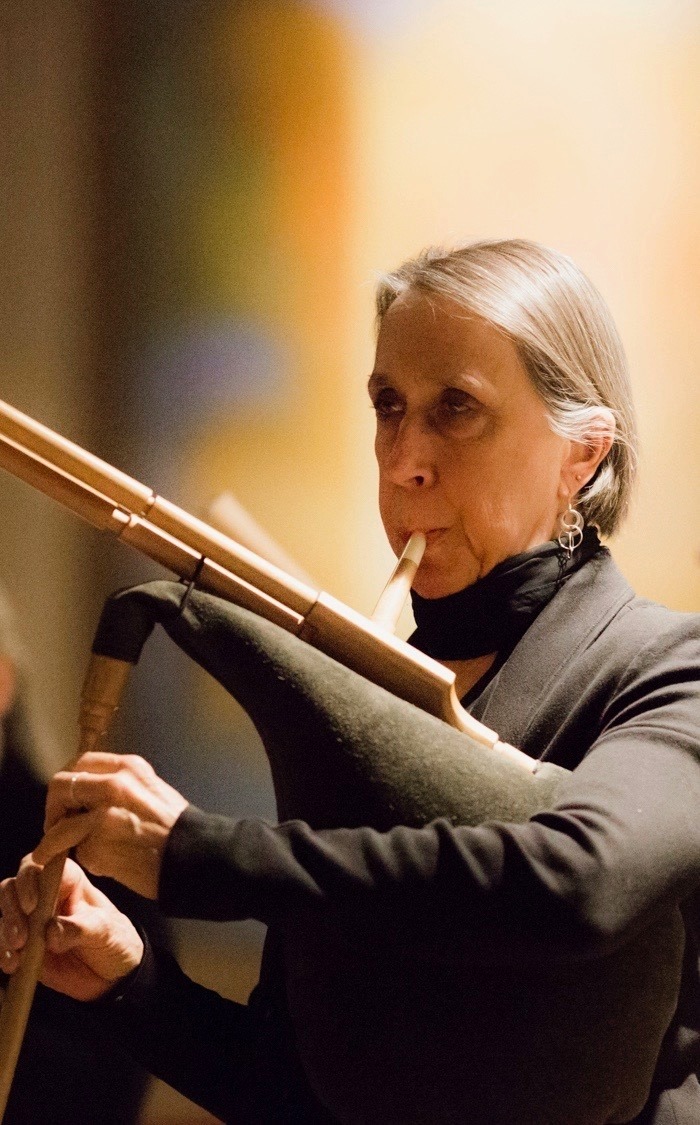
The main goal when the group was founded was to focus on and explore the possibilities of early double reed instruments, the shawm (ancestor of the modern oboe) and the dulcian (ancestor of the modern bassoon). Recorders were another logical instrument group to add to our mix, as they provided a quieter alternative to the sonorous reeds in our performances. I am not sure we would have considered bagpipes, if it weren’t for the fact that one founding member, Edwin George, was also a highland piper, and another founding member, Joel Robinson, an instrument builder. Joel made a pipe for Edwin modelled after various illustrations and paintings from the late medieval period, with a cylindrical bore, and a drone that played either in G or D. Edwin became the group’s sole piper, and we combined that pipe with shawms in four-part dance arrangements, the pipe being able to stand up fairly well over the reeds beneath it. After a few years, Edwin purchased a set of Grosser Bock pipes from Fritz Heller, providing another combination that worked well with tenor and bass shawms.
A radical change in personnel in 1989, with the original piper departing, opened up the opportunity for me to play the pipes in Piffaro concerts. At the same time two players with some piping experience joined the ensemble. All three of us now owned the same original model by Joel Robinson. With duo and even a few trio pipe arrangements now possible, Piffaro branched out from dances with pipe and multiple shawms to more varied tunes, some with pipes alone, and others with a variety of instruments and percussion. Still, however, having only one kind of pipe did limit the possibilities, and so the search was on for other styles. The next acquisition, a hummelchen by Paul Beekhuizen with double drones in F and C, modelled after Michael Praetorius’ illustration in his Syntagma Musicum of 1619, moved to the softer side of the dynamic spectrum and made for a sweet companion to recorders. Soon two mates, the so-called “fat kitchen” pipes in F with a single drone, also by Beekhuizen, joined the hummelchen for more duet and trio possibilities.
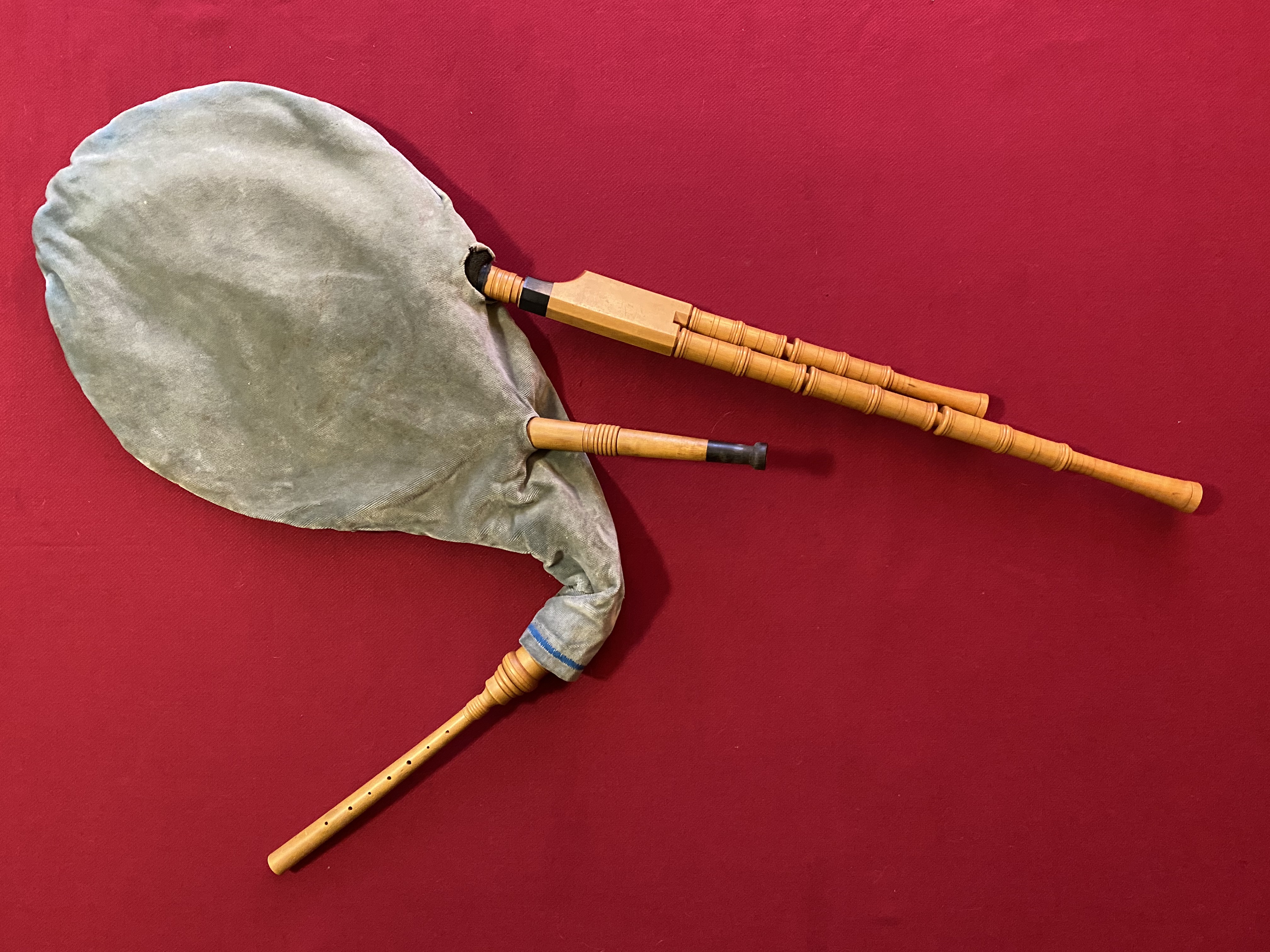
What was still missing in Piffaro’s collection, however, was a conically bored pipe with a fuller sound and a broader range. First in this category was a loud and sonorous Flemish style pipe with a single drone by Fritz Heller. This kind of pipe is seen frequently in the iconography, playing alongside the shawm, and it served that role well in the ensemble. Not long after, with another new member in the group eager to learn the pipes, Piffaro members purchased four Flemish pipes in G from Beekhuizen. These conically bored pipes, full but sweet sounding and capable of playing two or three notes in the upper register, provided us with opportunities to create three-part arrangements, often with the melody in the middle voice, a descant above and a harmony below.
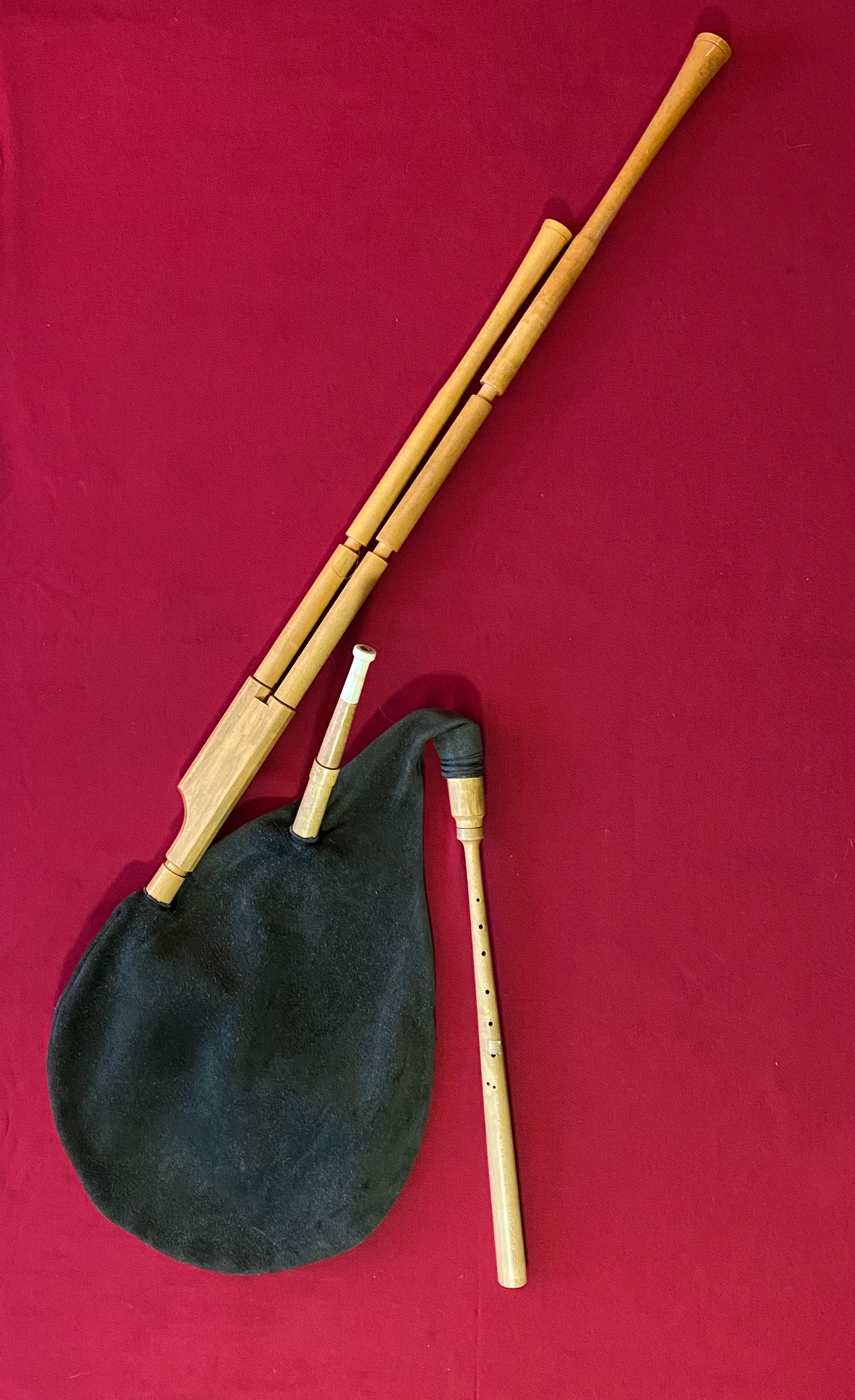
With this collection of pipes at our disposal, the possibilities were expanding dramatically. However, we threw a monkey wrench into the matter in 1994 by purchasing a full set of Renaissance recorders, from the soprano down to the contrabass, which were pitched at A463, about a half step higher than modern A440. After trying to manage our concert programs with our recorder sets at 463 and our reed and brass instrument sets and bagpipe sets at 440 and struggling with what that pitch discrepancy did to our ears, we finally changed the whole instrumentarium to 463 at the beginning of the new millennium. Our bagpipe makers, Beekhausen and Robinson, were gracious enough to make new chanters at the higher pitch, and we merely changed the pitch of the drones by adjusting the reeds. The only pipes that didn’t make the cut for this were the loud Flemish pipes. As a result, we commissioned a Flemish model from Robinson, a magnificent instrument in A, with a double drone at the fifth. This pipe was a perfect match for a new 463 shawm in D, and we love using that combination.
A few other pipes have entered our collection since 2000, including a French-style pipe by Bodo Schultz that paired well with the older Robinson pipes, a double chanter pipe by Jürgen Ross, and a hummelchen by Robinson that has the capability of G, D and F drones. As our personnel changed over the years, some of the pipes have left the group with their owners, which is the case with the fat kitchen pipes in F, and the French-style pipes. But we consider our current collection fully capable of meeting all our piping needs!
Pipe Reeds
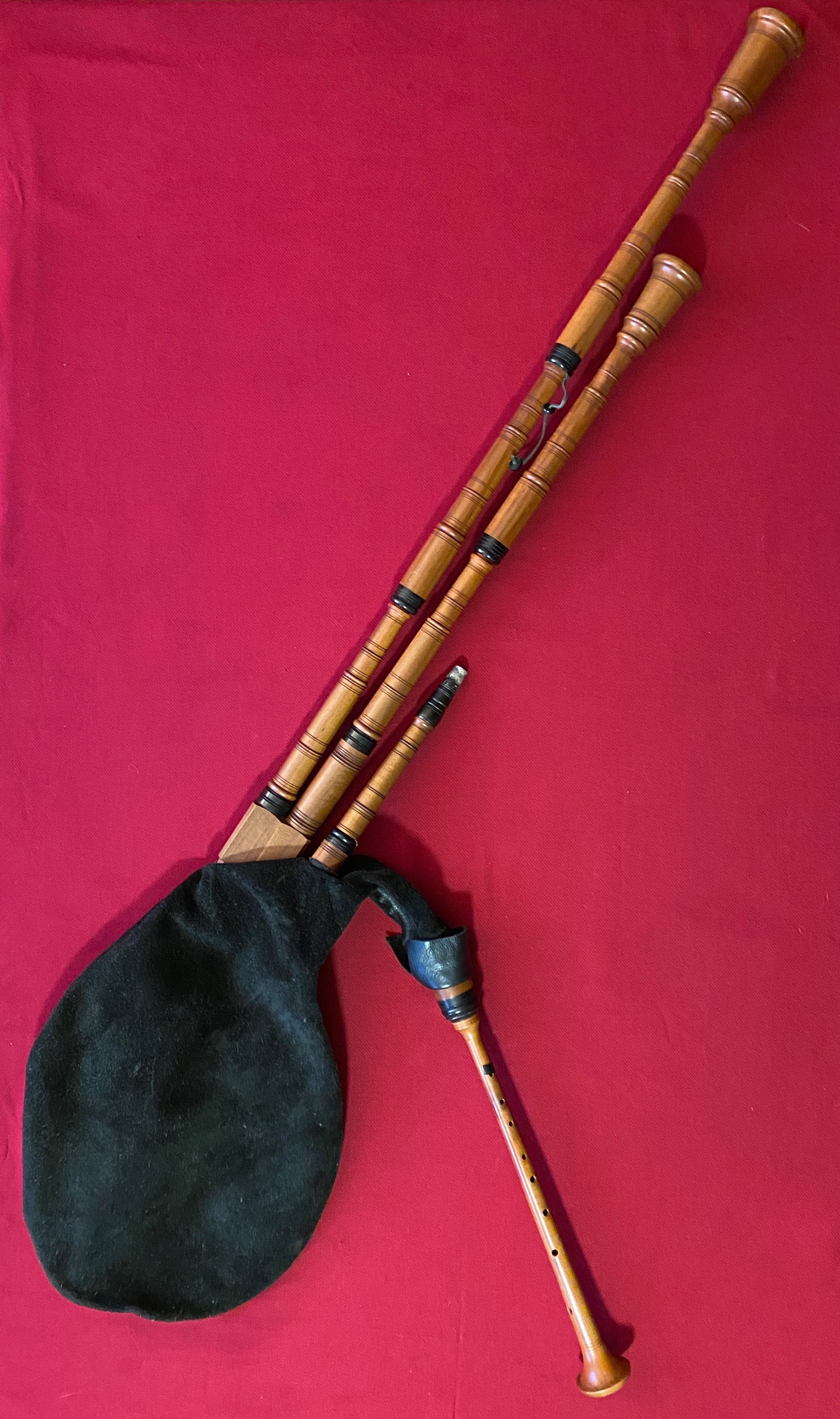
With only a few exceptions, the chanters in Piffaro’s pipes have cane double reeds, as do all the drones for the cylindrically-bored pipes. The drones for the conically-bored pipes use single beating reeds - the Heller G pipe drone with the old split tube cane reed, the drone reeds of the Beekhuizen G and the Robinson A pipes a combination of a plastic tongue tied over a wooden, plastic or metal shallot, a much easier reed to maintain, though maybe not as authentic! Since I had been making reeds for my shawms and dulcians, it was not a problem for me to take over the reed making of the Robinson pipes, modelling them after the reed that came with my instrument in 1988. In fact, I collaborated with Joel beginning in the mid-90’s on those pipes. He made the wooden parts, I made the bag and the reeds, assembled the pipe and did a final tuning before it was sent out to its new owner. In the early aughts, as I began to teach bagpipe playing at summer early music festivals, I asked Joel to design a hummelchen with a drone playable either in G or D that would be a good instrument for beginning pipers. In the period of about 10 years he made well over 20 of those pipes, and as with the others, I made the bags and the reeds and did the final assembly. We decided after a while, however, to experiment with plastic reeds for these instruments which would make maintenance easier for their owners. Rather than constructing them myself out of yogurt cup plastic (just couldn’t deal with an inert, inorganic material after working for so long with cane!), I bought plastic practice chanter reeds that I sized down and softened for the little pipes. After the first sets of double reeds from the Beekhuizen pipes either wore out or cracked, I made all those as well.
Piffaro’s instrumentation
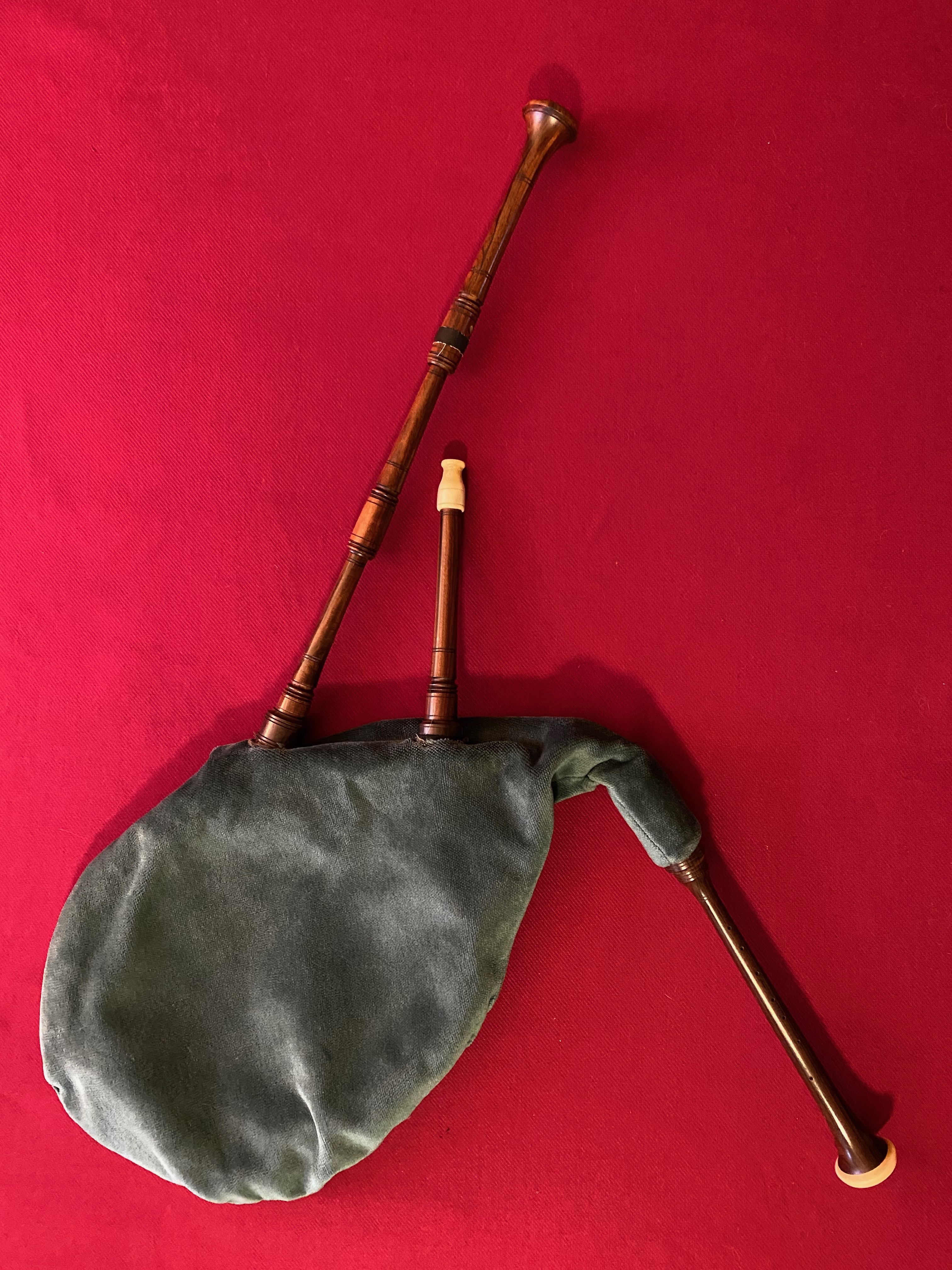
While Renaissance double reeds were our primary instruments in the earliest years, we soon added sackbuts, the forerunner of the trombone, into the ensemble. The combination of reeds and brass comprised the main instrument grouping of the 16th century wind bands, after which Piffaro has modelled itself. These early players also doubled on other instruments, which is why we frequently use our full complement of recorders, our consort of the capped double reed crumhorns, and other esoteric early wind instruments. In addition, we add plucked strings (guitar, lute and harp) and percussion (various tabor drums, tambourines and string drum) to the winds. AND of course, the pipes! While there are both iconographic and archival references to bagpipes joining the wind players in the late medieval period, evidence indicates that by the 16th century bagpipes were primarily an instrument of the lower classes. With our repertoire firmly located in the late 15th through the mid-17th century, the heyday of the wind bands, we address that issue by playing both sides of the fence, on the one hand modelling ourselves after the wind players hired by the courts, cities and cathedrals, and on the other, the rustic bands who entertained the populace at weddings, parties and various outdoor occasions (think of the wonderful paintings by Breughel!)
Piffaro repertoire
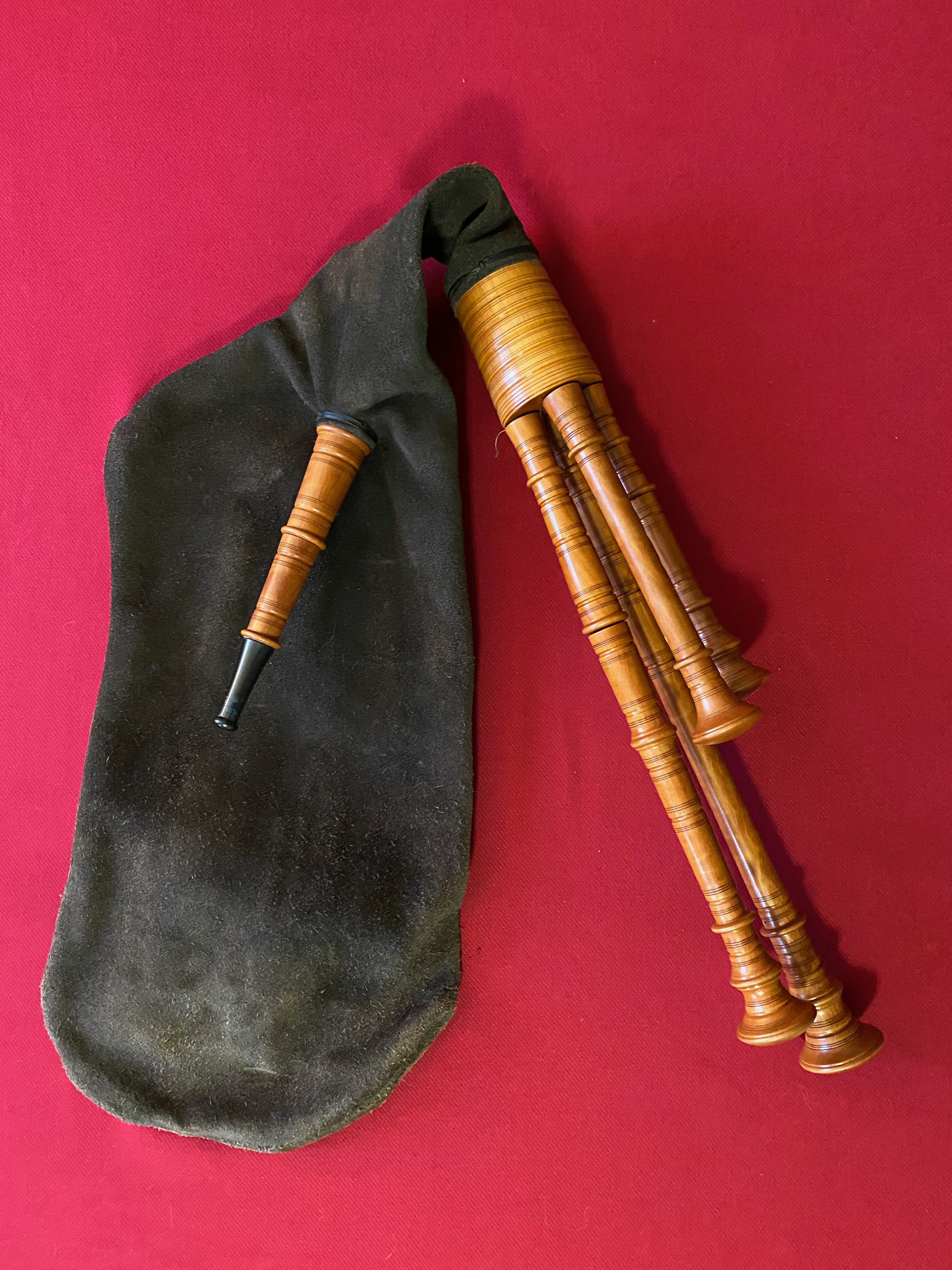
With the exception of dance music, which was probably standard fare for the wind players, there is a paucity of instrumental composition in the first half of the 16th century. There is good evidence, however, that the wind bands of the time played a great deal of vocal repertoire, both sacred and secular. Instrumental consorts or families were built in the sizes matching the ranges of the human voice, from soprano through alto and tenor to bass. Indeed, it seems that the aim of the instrumentalists was to imitate the human voice as they focused bringing out the flow and accents of the texts. That’s precisely what the Piffaro wind players do – in fact, we consider ourselves wanna-be singers! And we play a wide variety of vocal music, from sacred motets, masses and hymns to secular Italian and English madrigals, French chansons, German Tenorlieder, and Spanish villancicos. There is an endless supply of this repertoire from which we have gathered a prodigious number of pieces for the variety of programs we’ve built and performed over our 40-year existence. And we play these pieces on our reeds and brass combination, on our recorder and krumhorn consorts, or on combinations of recorders and plucked strings. Frequently we combine forces with singers, doubling their parts with our instruments, or accompanying a solo voice with instruments beneath.
BUT, a Piffaro program would not be a PIFFARO PROGRAM without bagpipes. Our audiences have come to expect that, and we aim to please, whether it’s with rousing dance music accompanied by guitar and percussion, or a soulful tune arranged in harmony for three pipes. Our experimentation with combinations of pipes and other instruments has resulted in a wide variety of possibilities, depending on the kind of pipes we chose. We’ve also learned what combinations work and which ones are less successful, and sometimes the results are surprising. Recorders with our Flemish G pipes? You would think that the recorders would be completely drowned out by the buzz of the drones and the chanters, but the three tenor recorders that we have used with three sets of those pipes hold their own very nicely. We have combined pipes with singers in a beautiful Italian laude (a sacred song), placed a quartet of crumhorns underneath two pipes in a rousing brawl, and brought together a sweet F pipe with a soprano recorder in an enchanting arrangement of a German folk tune. Are all these combinations authentic to the period? Perhaps not, but our goal is not only to be rigorous in our research into the music and performance practices of the period, but also to be innovators and entertainers, creating new ways of bringing this music to modern ears.
Making the arrangements
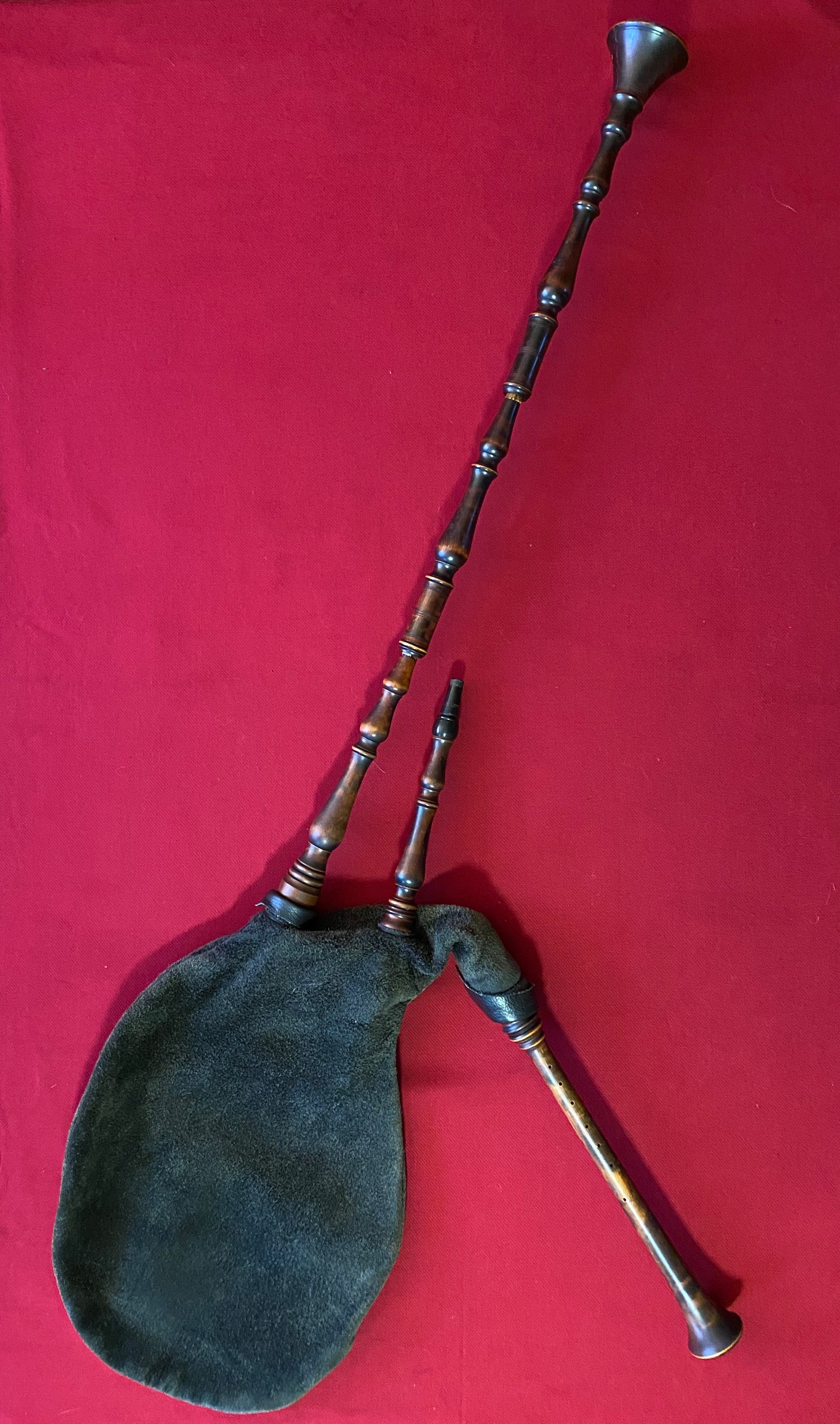
I did a quick survey back through our old programs and recordings and counted close to 70 arrangements and settings for bagpipes that Piffaro has created over its 40-year history. So, how do we go about making arrangements for our pipes? Where do we get the tunes and the dances from which to build those arrangements? From the beginning of our history, one of the most fertile sources has been the multitude of four-part dance settings printed in the 16th century – the many volumes of the publisher and arranger Pierre Attaingnant, Tylman Susato’s Dancerye (1551) Jacques Moderne’s Musique de Joye (c.1550), and others. Sometimes we would take those settings “as is”, with the bagpipe on the top line and the supporting shawms, sackbuts and dulcians beneath. That was the predominant way in the first eight years of Piffaro’s history when there was only a single piper in the ensemble. When new members proficient on pipes joined the group, more possibilities arose. Those same dance tunes were still valuable sources, but frequently we would “deconstruct” them, retaining the melody and the tenor, which with certain judicious tweaks could form a nice duet, and writing a descant line that fit well with the existing two. A collection of monophonic ballo tunes from the late 15th century proved to be another rich source for pipes, and from them we created numerous arrangements of duets and trios.
The Renaissance period is rich in melodies that have narrow ranges well suited to the bagpipe, so we look not only to the dance collections but also to the vocal repertoire for our material. Here the process of creating the arrangements can be similar – sometimes “deconstructing” and “reconstructing” a four-part setting, other times composing new lines to accompany a monophonic tune. A number of our arrangements are the result of improvisations experimented with in rehearsals that are subsequently written down. For some of our Spanish arrangements, we mined the collections of 17th century variations on dance tunes, stringing the most suitable ones together and adding our own improvisations in the midst.
Here are some examples of Piffaro’s pipe settings, describing their instrumentation, the origins of the tune and how they were arranged.
Bransle des Chevaux
This Piffaro favourite goes way back to our beginnings and has gone through numerous iterations since. The tune is from Thoinot Arbeau’s 1589 dance manual Orchesographie, and only exists in its monophonic form. We added three lower voices for a shawm, a sackbut and a dulcian to create the standard four-part setting. In most of our performances of this piece, we started with the pipe and guitar, added a high recorder on a repeat of the tune, and brought in the reeds and the brass for a final time through. This classic ensemble of instruments was the standard at the beginning of Piffaro’s existence, but ceded priority to others as the pipe instrumentarium grew.
La Bergere and Bockxvoetje
The first pipe played in Piffaro, made by Joel Robinson, has remained a perennial favourite, and has been incorporated into many a program since the beginning. This suite of two tunes from Jacob Van Eyck’s Der Fluyten Lusthof (1644) is one of the latest, arranged for a video production based on Van Eyck’s music and streamed in the fall of 2020. The tunes, one French, the other probably English (despite the Dutch name), are some of the few in the book that fit the range of the pipes. For this arrangement we used each tune with one of Van Eyck’s variations and composed a counter melody weaving around the original. Guitar and string drum accompanied the pipes.
Bransles d’Ecosse
This arrangement is an example of a “deconstruction” of a four-part dance setting, from a mid-century print of French dances arranged by Etienne du Tertre. Three of the “Robinson” pipes, as we always refer to them, play the melody in unison, then break into two and three parts at the repeats. No other instruments or percussion accompany the pipes.
Vos Virgen soys nuestre madre
Here we take an anonymous three-part Spanish sacred villancico from the Cancionero de Upsala (1556) and play the top two lines on the Robinsons, and the third line on a Robinson outfitted with an alto chanter. The simple lines are ornamented by the players on the second and third times through. While this piece happens to work beautifully for the three pipes, we rarely use a fully composed piece for our trio arrangements, for the simple reason that there are not many with all the lines suitable for the pipes that we play.
In feurs hitz
This is an example of a fully composed piece that works well for a combination of the sonorous Flemish pipe in G and a trio of shawms. In feurs hitz is a typical German composition with the melody in the tenor voice. Our arrangement begins with the pipe on the melody (played an octave higher than written), joined the second time through by the soprano shawm. The third iteration has an alto shawm doubling the melody at pitch, and finally a fourth time brings in the 2nd and 4th lines on another alto and a tenor shawm. We have added nothing to the original composition but have created the “story” by adding voices one at a time.
Senhora del mundo
While the Robinson pipes have been and always will be much beloved by the Piffao pipers, the Flemish pipes in G by Beekhuizen have proven to be immensely useful in three-part arrangements. Although also conically bored, they are sweeter than the set by Heller, blend well together, and are also happy with recorders, as we have discovered in recent years. Senhora del mundo, a monophonic Portuguese song in praise of the Virgen, features the pipes first in unison, then two and and finally three parts, with one voice playing a higher descant. We added a variation in three parts, and at the end return to the single melody.
Alta trinita beata
We don’t know of too many early music ensembles that ask vocalists to sing with pipes, and while this is not a frequent practice of ours, we have created some unusual arrangements, including this stunning one. The monophonic tune is a 15th century Italian laude, or song of praise, and we arranged it for a Florentine program that we performed and recorded with The Concord Ensemble, a five-part men’s group specializing in early music. The middle section is an arrangement of the Italian dance La Mantovana, which provides a foil to the laude. Like Senhora del mundo, this arrangement is in three parts, with one taking the higher descant line.
Ballet des aveugles
The pairing of a bagpipe and a double reed instrument has a long history that continues into folk cultures of the present time. There are numerous examples in the iconography of the 15th and 16th centuries of a pipe and a soprano shawm, and in Italy even today one finds the pairing of a zampogna and a chiaramella, and in France the bombarde and binou. For this arrangement, we “deconstructed” a four-part dance from Terpsichore, Michael Praetorius’ voluminous collection of 16th century dances, to play on the Flemish pipe in A, accompanied by a soprano shawm in D, a key pairing that works well, since the pipe’s primary octave is a 5th above the shawm, making it possible for a duet in a soprano and a tenor range.
Villano
This is a popular Spanish song about a peasant eating onions and bread. It was also a dance tune and appears in a collection of 17th century Spanish dances with variations. We have taken the tune, borrowed some of the variations, and added our own improvisations in an arrangement for two hummelchen, two soprano recorders, guitar, harp, and string drum.
A Medley of German chorale melodies: Dies est laetitiae, Psallite unigenite, In dulci jubilo
In this arrangement of German Christmas chorales, we borrowed from the numerous two-, three- and four-part settings by Michael Praetorius to fit on an ensemble of hummelchen, three recorders, 2 crumhorns, guitar and soprano voice. In this instance the hummelchen lays down the opening phrase of the first melody, quickly joined by a bass and then an alto recorder, first in a duple setting, followed by a triple. Psallite unigenite opens with the pipe, joined then by two high recorders. A tenor and bass krumhorn and a guitar fill out the four-part harmony in the second iteration of the chorale. In dulci jubilo is scored first for voice and pipe, a second time for pipe and two recorders, and a final iteration brings the whole ensemble together in a four-part setting.
It has been a joy over the years to have bagpipes be an integral part of my musical life, as a performer, a teacher, an arranger of music, and a reed maker. It has also been most satisfying that bagpipes have had such an important role in Piffaro’s music making since its beginnings in 1980, and have given such pleasure to our audiences. There’s nothing like a rousing bagpipe arrangement at the end of a concert to send people into the aisles and out of the hall dancing!
Please follow this link to listen to the original sound recordings of each of the above tracks, accompanied by the sheet music arrangement for each piece.
| Pipe | Maker | Chanter Range | Bore | Drone | Reeds | Dates |
|---|---|---|---|---|---|---|
| Medieval style | Joel Robinson | C to e♭ | cylindrical | Single, D or G | cane double reeds - chanter & drone | 1982 - present |
| Grosser Bock | Fritz Heller | Tenor C to D | cylindrical | Single, D | cane double reeds - chanter & drone | 1983 - 1989 |
| Alto chanter | Joel Robinson | F to g | cylindrical | cane double reed | ||
| Hummelchen | Paul Beekhuizen | C to d | cylindrical | Double, F and C | cane double reeds - chanter & drone | 1990 - present |
| Flemish style | Fritz Heller | f to aa | conical | Single, G | cane double reed - chanter, cane single reed - drone | 1995-2000 |
| Fat kitchen | Paul Beekhuizen | C to d | cylindrical | Single, F | cane double reeds - chanter & drone | 1995-2006 |
| Flemish style | Paul Beekhuizen | f to b♭ | conical | Single, G, Double G & D | cane double reed - chanter, plastic single reed - drones | 1997 - present |
| French | Bodo Shultz | C to d | conical | Double, D & D | plastic double reed - chanter, plastic single reed - drones | 2002 - 2018 |
| Flemish style | Joel Robinson | g to b♭ | conical | Double, A & E | cane double reed - chanter, wood/plastic single reed - drones | 2001 - present |
| Hummelchen | Joel Robinson | C to d | cylindrical | Single, D, G or F | plastic double reeds - chanter & drone | 2003 - present |
| Medieval zampogna | Jürgen Ross | 1. e to c and 2. F to C | cylindrical | Double F & C | plastic double reeds - chanter & drones | 2007 - present |
- Data Processing Notice (GDPR)
@BagpipeSociety on X (formally known as Twitter)
TheBagpipeSociety on Instagram
 BagpipeSociety on Facebook
BagpipeSociety on Facebook
Something wrong or missing from this page? Let us know!
